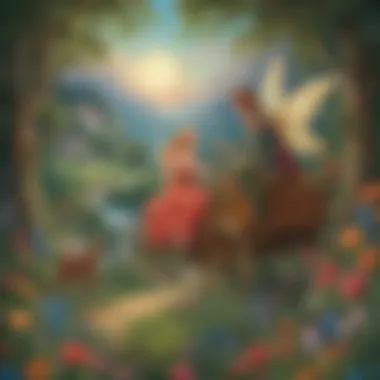Exploring Free Fairy Tale Books for Young Readers


Intro
Fairy tales have held a special place in children's literature for centuries. Their timeless narratives capture the imagination and transport readers to enchanted worlds. With the rise of digital technologies, many platforms now offer free fairy tale books that are easily accessible. This article focuses on the significance of these resources, their educational value, and methods for engaging young readers.
In addition to availability, we will explore various platforms where these books can be found. We will also dive into the benefits of fairy tales in early literacy development and creativity enhancement among elementary school children.
Accessing free fairy tale books can open up a wealth of opportunities for learning and growth. It allows children to appreciate classic stories and learn important moral lessons. Moreover, it fosters a love for reading early on. Let's take a deeper look at how these resources can enrich the lives of young readers.
Creative Activities
Engaging children in creative activities related to fairy tales can significantly enhance their reading experience. Creativity stimulates their minds and allows for personal expression. Here are some ways to incorporate creative activities:
Craft Ideas
- Story Character Puppets - Children can create puppets of their favorite characters from the fairy tales they read. This promotes creativity and helps them recall story elements.
- Book Covers - Encourage children to design their own book cover based on a fairy tale. This not only reinforces the story but also fosters artistic skills.
- Nature Collages - Kids can collect leaves, flowers, or other natural materials to create art inspired by fairy tales.
Step-by-Step Guides
Each creative activity can be broken down into simple steps:
- Gather Materials for the chosen activity.
- Follow Instructions - Provide clear, concise directions to guide the children.
- Share and Reflect - After completing the task, allow time for sharing results and discussing the process.
Educational Value
Engaging in creative activities tied to fairy tales can
- Enhance comprehension through hands-on experiences.
- Improve fine motor skills as children cut, glue, and assemble.
- Promote collaboration when working in groups, building social skills.
Fun Quizzes
To further enhance children’s understanding of fairy tales, interactive quizzes can be a great tool. They not only reinforce knowledge but also make learning enjoyable.
Quiz Topics
Quizzes can cover a variety of topics, such as:
- Characters in different fairy tales.
- Plot summaries and main events.
- Moral lessons from the stories.
Question Types
- Multiple Choice - Kids can choose the correct option related to information from the fairy tales.
- True/False - Simple statements based on the narratives encourage quick responses.
- Fill in the Blanks - This format tests knowledge while promoting recall.
Knowledge Reinforcement
Quizzes can help reinforce learning by
- Providing immediate feedback on children’s knowledge.
- Encouraging them to review material where needed.
- Making the process of learning fun and engaging.
Fact-Based Articles
In addition to stories and quizzes, fact-based articles allow children to learn more about the world of fairy tales and their backgrounds.


Topics
These articles can cover diverse topics such as:
- Origins of specific fairy tales.
- Cultural impacts on storytelling.
- Differences between various versions of the same tale.
Engaging Content
The articles should present information in a clear, engaging manner. Simple language and vivid illustrations can make understanding easier for young readers.
Understanding Fairy Tales
Fairy tales hold a unique place in the realm of children's literature. They are not just enchanting stories but also tools that shape the early experiences of young readers. Fostering a love for reading at a young age sets the foundation for lifelong learning. Understanding fairy tales allows parents and educators to harness these stories for educational and developmental benefits.
Definition and Characteristics
Fairy tales consist of traditional narratives often featuring magical elements, imaginary worlds, and character archetypes such as heroes, villains, and wise beings. The definition of fairy tales can vary, but they typically share certain characteristics:
- Structure: Many fairy tales follow a clear beginning, middle, and end, which helps children understand story structure.
- Characters: Common character types include the protagonist, an antagonist, and magical creatures.
- Themes: Recurring themes, like good versus evil, the journey of self-discovery, and the importance of courage, impart significant lessons to young readers.
- Morality: Most fairy tales include a moral lesson that resonates with the reader.
These elements work together to captivate children's imagination and create memorable reading experiences.
Cultural Significance of Fairy Tales
Fairy tales have been passed down through generations, adapting to various cultures while retaining key themes and values. They serve not only as entertainment but also as cultural artifacts. The cultural significance of fairy tales can be explored in several ways:
- Reflection of Values: Fairy tales often reflect the values and beliefs of the society from which they originate, providing insight into cultural norms.
- Comparative Study: They allow for comparative studies across cultures, showcasing similarities and differences in storytelling traditions.
- Preservation of History: Fairy tales preserve historical narratives and cultural myths, making them a vital resource for understanding cultural heritage.
In sum, fairy tales offer enriching experiences that go beyond mere storytelling, making them essential for young readers' growth and comprehension of the world.
The Importance of Fairy Tales for Children
Fairy tales play a significant role in a child's development, advancing not only their imagination but also their understanding of various concepts. These stories serve as an engaging method to introduce children to new ideas, morals, and cultural narratives. The importance of fairy tales extends beyond mere entertainment; they contribute to cognitive and emotional growth that can last a lifetime.
Fostering Imagination and Creativity
Fairy tales are rich in imaginative elements that transport children to different worlds. This exposure encourages them to think creatively. When young readers immerse themselves in stories featuring magical beings, whimsical kingdoms, and extraordinary adventures, they begin to expand their own imaginative faculties.
Reading such tales stimulates their ability to visualize unique scenarios. It is not just about engaging with the text but creating mental images that might inspire future creativity.
- Imagination development: Children learn to envision possibilities beyond their immediate reality.
- Problem-solving skills: Facing various challenges in fairy tales helps children think critically about solutions.
The routine engagement with fantastical settings and characters acts as a catalyst for creative thought processes. Therefore, fairy tales are crucial in fostering an innovative mindset.
Moral Lessons and Values
Fairy tales often convey essential moral lessons through their plots and characters. These stories teach young readers important values such as kindness, honesty, and friendship. For instance, common themes involve the triumph of good over evil, emphasizing virtues that children can learn from and apply in their lives.
Accessing Free Fairy Tale Books
Accessing fairy tale books for children is essential in fostering their love for reading. With so many options available, finding free resources can help parents and educators provide engaging literature without incurring costs. Free fairy tale books allow children to explore their imagination and creativity through rich stories.
Online Resources for Free Books


Public Domain Resources
Public domain resources offer a vast collection of fairy tales that are free to access. These tales have no copyright restrictions, allowing anyone to share and adapt them. Notable platforms include Project Gutenberg and Internet Archive. The key characteristic of public domain resources is their accessibility to all. This makes them a popular choice for parents and educators seeking classic tales.
A unique feature of these resources lies in their extensive catalogs. They often provide original texts along with illustrations, enhancing the reading experience. However, users should be aware that some of these texts may be dated or contain language that is less approachable for modern readers.
Library Websites
Many library websites provide free access to fairy tale books. Public libraries often have digital lending systems, allowing families to borrow e-books for a limited time. The key characteristic of library websites is their variety of genres, which include classic and contemporary fairy tales. This variety makes them a beneficial option in this article.
Something unique about library websites is that they often feature curated collections. They select popular and high-quality fairy tales, making it easier for users to find suitable materials. On the downside, users may need a library card or account, which can be a barrier for some families.
Educational Platforms
Educational platforms are increasingly hosting free fairy tale books for young readers. Websites like Storyline Online and Epic provide access to many children's stories. The key characteristic of these platforms is the focus on engagement, utilizing audio narrations and interactive elements. This focus makes them an excellent choice for educational use.
A unique feature of educational platforms is the integration of learning activities associated with the stories. These activities can help reinforce the lessons found within the tales. However, users may face limitations on access due to subscriptions or the need for educator accounts, which can restrict availability.
Mobile Applications Offering Free Fairy Tales
Many mobile applications allow children to read or listen to fairy tales for free. Apps like Libby, Kindle, and Storynory provide access to a collection of stories on smartphones and tablets. This means children can enjoy tales anytime, anywhere. It's an efficient way to enhance their literacy skills while having fun with fairy tales.
Overall, accessing free fairy tale books is a wonderful opportunity for parents and educators. It allows children to develop a love for reading, creativity, and moral understanding. By utilizing online resources, library websites, and mobile applications, families can easily find quality fairy tales that enrich young minds.
Popular Free Fairy Tale Collections
Free fairy tale collections serve as vital resources for young readers. They usually include timeless stories that shape a child's understanding of narrative structure, morals, and imagination. This aspect is especially valuable for parents and educators aiming to instill a love of reading in children. The accessibility of these collections enables families from different backgrounds to share in the experience of storytelling.
Classic Fairy Tales
Classic fairy tales form the backbone of children's literature. These narratives often feature familiar themes such as good versus evil, adventure, and the triumph of the underdog. Stories like Cinderella, Little Red Riding Hood, and Snow White resonate across generations. These tales not only entertain but also convey moral lessons, making them a staple in childhood reading.
These stories provide cultural context and historical significance. By exposing children to classic fairy tales, parents help them understand societal values from the past. Furthermore, many of these stories have been preserved in the public domain, allowing educators to access them freely and share them with students.
"Classic fairy tales are an essential tool for teaching children about life and society's values through storytelling."
Reading classic fairy tales can enhance children's vocabulary and comprehension skills. The language used in these stories encourages children to explore new words and phrases, thereby improving their overall literacy levels. Schools often integrate these tales into their curricula, thus providing an enriching literary experience.
Modern Adaptations
Modern adaptations of fairy tales have gained popularity in recent years. These adaptations often reimagine classic tales with contemporary twists or diverse perspectives. Stories such as The Paper Bag Princess by Robert Munsch or Ella Enchanted by Gail Carson Levine provide fresh narratives that still connect to their original themes.
One of the benefits of modern adaptations is that they can address current societal issues. For example, some adaptations focus on feminism, inclusivity, or environmental concerns. This makes the stories relatable to today's young readers who are navigating a vastly different world than that of their predecessors.
Additionally, these adaptations often feature illustrations that appeal to modern sensibilities. The integration of diverse characters and settings can create a more inclusive reading environment. This is crucial for fostering empathy among young readers, as they learn to appreciate various cultures and experiences.
Incorporating Fairy Tales into Learning
Fairy tales are not just delightful stories for children; they can also be powerful tools for learning. Incorporating fairy tales into educational settings offers numerous benefits to young readers. These narratives captivate children’s imagination and foster essential skills such as critical thinking, language development, and social understanding. By weaving fairy tales into lesson plans, educators can create a rich environment where children not only enjoy stories but also glean valuable lessons from them.
Storytelling Techniques for Educators


Educators can utilize various storytelling techniques to make fairy tales engaging and impactful. Here are some effective methods:
- Dramatic Read-Alouds: Teachers can read fairy tales aloud with expressive voices and gestures. This technique helps children immerse themselves into the story, enhancing their emotional connection to the characters.
- Role-Playing: Encouraging students to act out parts of a fairy tale allows them to explore characters' motivations and emotions. This active participation bolsters comprehension and empathy.
- Story Mapping: Using visual aids like charts or drawings, instructors can guide children in summarizing fairy tales. This method helps students understand structures of narratives, such as settings and plot twists.
By adopting these techniques, educators can maintain high engagement levels while maximizing educational outcomes.
Interactive Activities Based on Fairy Tales
To complement storytelling, interactive activities can augment the learning experience. These activities promote engagement and reinforce the lessons found within fairy tales:
- Art Projects: Students can create illustrations or dioramas of their favorite scenes. This exercise encourages creativity and can solidify story comprehension.
- Writing Exercises: Children can be tasked with rewriting fairy tales with alternate endings. This not only fosters writing skills but also stimulates critical thinking about stories.
- Discussion Circles: Facilitate group discussions where children share their interpretations of a fairy tale. This format can encourage diverse perspectives and enhance critical analysis.
Incorporating such activities transforms fairy tale reading from a passive experience into an active and dynamic part of children's education. By engaging students in different ways, educators can nurture a love for reading and set a foundation for lifelong learning.
Fairy tales are not mere entertainment. They are vehicles for complex ideas and values that can shape young minds.
Challenges in Accessing Free Fairy Tales
Accessing free fairy tales can be a rewarding experience for young readers, but several challenges can hinder this pursuit. Awareness of these challenges is crucial for parents and educators. It enables them to find effective solutions and ensure children have the opportunity to engage with literature. This section discusses two prominent challenges: the digital divide and the quality control of online resources. Each plays a vital role in the accessibility of fairy tales.
Digital Divide
The digital divide refers to the gap between individuals who have easy access to digital technology and those who do not. In many places, access to the internet is limited. Some families may only have one device shared among several members. Consequently, children in these households face obstacles in accessing free fairy tales online.
The implications are significant. When children cannot easily find and read fairy tales, they miss out on valuable educational content. This can affect their creativity and literacy development. To address this divide, communities can implement initiatives to provide devices and internet access. Libraries often serve as critical hubs for free resources. They can also offer programs that teach children how to find and use digital materials effectively.
Key Considerations:
- The availability of devices for each child.
- Reliable internet connection.
- Community programs that promote digital literacy.
"Bridging the digital divide is essential for ensuring every child has equal access to educational resources, including free fairy tales."
Quality Control of Online Resources
Quality control is another major challenge. There is an abundance of online resources that offer free fairy tales, but not all of them are trustworthy or well-curated. Some websites may provide poorly edited content, inaccurate adaptations, or even outdated tales. This can lead to confusion or misinterpretation of stories, which is particularly concerning for young readers who are still learning.
Parents and educators must be discerning about where to find fairy tales. They should seek platforms known for quality resources. These could include established library websites or educational platforms like Project Gutenberg. These trusted sources often guarantee a higher standard of content.
Important Points to Consider:
- Evaluating the credibility of websites.
- Seeking recommendations for reliable sources.
- Encouraging critical thinking in children regarding online quality.
Accessing free fairy tales can enrich children's lives greatly. However, being aware of these challenges helps us address them effectively. By providing solutions, we can create a more inclusive environment for discovering literature.
Epilogue
In this article, we have explored the richness and accessibility of free fairy tale books as a vital resource for young readers. The importance of fairy tales lies not only in their ability to enchant and entertain but also in their significant contributions to children's literary development. These narratives foster imagination, impart moral lessons, and are crucial for enhancing language skills.
The Future of Fairy Tales in Digital Education
The future of fairy tales in digital education appears promising, as technology continues to reshape how we access literature. Digital platforms offer expansive libraries filled with fairy tales, easily accessible to children around the world. This accessibility can bridge gaps in education, allowing children from diverse backgrounds to engage with stories that enrich their understanding of various cultures.
Emerging technologies, such as augmented reality and interactive storytelling applications, can augment the traditional fairy tale experience. By enhancing engagement, these tools can help maintain children's interest in reading as they grow.
As educators and parents, focusing on integrating these digital resources into teaching strategies can cultivate a lasting love for reading among children. Keeping pace with these developments ensures that fairy tales evolve in tandem with educational frameworks, benefiting the next generation.
Encouragement for Parents and Educators
Parents and educators play a crucial role in nurturing young readers through fairy tales. It is important to encourage children to explore various fairy tale collections and adapt tales based on their interests.
- Family Reading Time: Designate time for family reading sessions featuring fairy tales, fostering an environment of shared storytelling.
- Discussion and Reflection: After reading, discuss the stories' themes and lessons with children, allowing them to express their thoughts and insights.
- Creative Projects: Engage children in activities that extend the fairy tale experience—crafting illustrations, writing alternate endings, or even staging their own plays based on the stories.
Relevant platforms such as Project Gutenberg or local library websites offer access to a treasure trove of free fairy tales. By promoting the exploration of these resources, parents can guide their children on a journey that lasts beyond the pages of books and into their understanding of real-world values and concepts.
"Fairy tales are not just stories; they are a powerful tool for education and development for young minds."
Encouraging exploration and critical thinking while interacting with fairy tales can lay the groundwork for a brighter future for children, both academically and socially.







